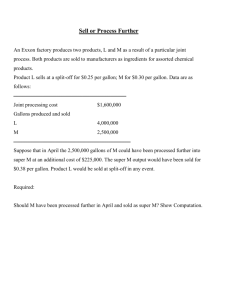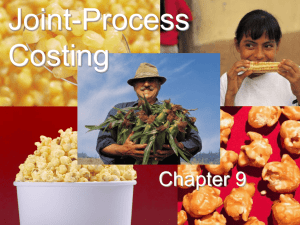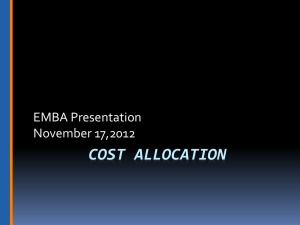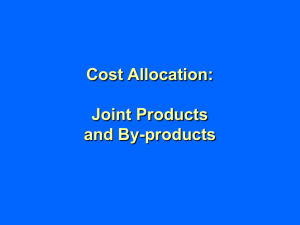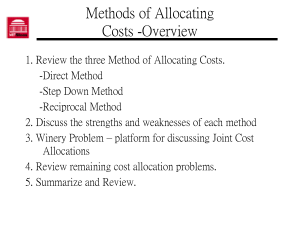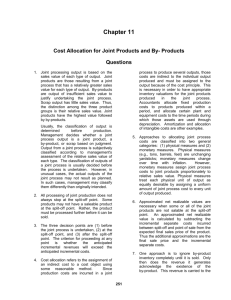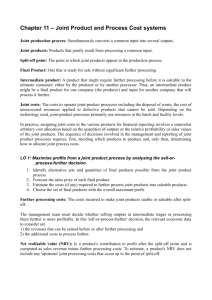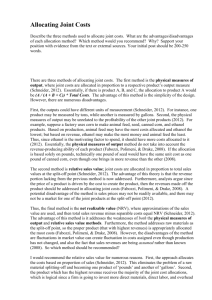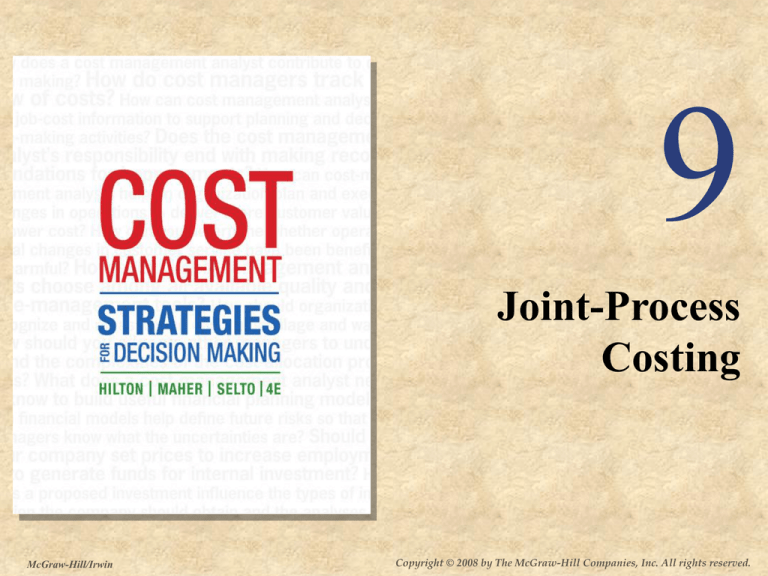
9
Joint-Process
Costing
McGraw-Hill/Irwin
Copyright © 2008 by The McGraw-Hill Companies, Inc. All rights reserved.
9-2
Joint Product Processes
A number of products are produced
from a single raw material input.
Product 1
Single Input
Product 2
Product 3
9-3
Joint Product Processes
Concept: in some industries, a number of products are
produced from a single raw material input.
Key terms:
Joint products – products resulting from a process
with a common input.
Split-off point – the stage of processing where joint
products are separated.
Joint costs – costs of processing joint products
prior to the split-off point.
Final product – ready for sale without further
processing.
Intermediate product – requires further processing
before sale.
9-4
Joint Product Processes
Consider the following
example of an oil refinery.
We will assume only two
products, gasoline and oil.
9-5
Joint Product Processes
Final
products
Intermediate
products
Joint
Costs
Joint
Input
Oil
Common
Production
Process
Final
Sale
Separate
Processing Costs
Gasoline
Split-Off
Point
Separate
Processing
Separate
Processing
Separate
Processing Costs
Final
Sale
9-6
Learning Objective 1
9-7
The Decision Challenge: Which
Joint Products to Produce
Identify final
products possible
from the joint
process.
Forecast the
sales price of
each final
product.
The usual objective in the
production of joint products
is to maximize profits.
Choose the set
of products
with the overall
maximum profit.
Estimate costs
to further process
joint products into
final products.
9-8
Learning Objective 2
9-9
Decision to Sell Products at Split Off
or Process Them Further
Joint product costs incurred prior to the split-off
point are sunk costs — not affected by a
decision to process further after the split-off
point.
A product should be processed beyond the
split-off point only if if the incremental revenue
exceeds the incremental processing costs.
Value is added only if the
incremental value from
processing exceeds the
incremental processing costs.
9-10
Decision to Sell Products at Split Off
or Process Them Further
Sawmill, Inc. cuts logs from which
unfinished lumber and wood chips are the
joint products.
Unfinished lumber is sold “as is” or
processed further into finished lumber.
Wood chips can also be sold “as is” for
landscaping or processed further into 4 × 8
composition boards.
9-11
Decision to Sell Products at Split Off
or Process Them Further
Data about Sawmill’s joint products includes:
Per Log
Wood
Lumber
Chips
Sales value at the split-off point
$
140
$
40
Sales value after further processing
270
50
Allocated joint product costs
176
24
Cost of further processing
50
20
9-12
Decision to Sell Products at Split Off
or Process Them Further
Analysis of Sell or Process Further
Per Log
Wood
Lumber
Chips
Sales value after further processing $
270
$
50
Sales value at the split-off point
140
40
Incremental revenue
130
10
Cost of further processing
50
20
Profit (loss) from further processing $
80
$
(10)
9-13
Decision to Sell Products at Split Off
or Process Them Further
Analysis of Sell or Process Further
Per Log
Wood
Lumber
Chips
Sales value after further processing $
270
$
50
Sales value at the split-off point
140
40
Incremental revenue
130
10
Cost of further processing
50
20
Profit (loss) from further processing $
80
$
(10)
Should we process the lumber
further and sell the wood chips “as is?”
9-14
Learning Objective 3
9-15
Reasons for Allocating Joint Costs
To measure performance based on earnings
To value inventory for financial statements
To estimate casualty losses
To determine and respond to rate regulation
To specify and resolve contractual interests
and obligations
9-16
Learning Objective 4
9-17
Joint Cost Allocation Methods
Physical
measure method
Monetary
measure method
Joint costs are
allocated based on a
proportional measure
(weight, volume, etc.) of
the joint products at the
split-off point.
Joint costs are
allocated based on
the relative values
of the products at the
split-off point.
9-18
Allocating Joint Costs
Joint
costs
If we allocate the joint costs of raising an animal to
the two products based on weight, which product
would receive the largest cost allocation?
Hamburger, because there is more of it.
9-19
Allocating Joint Costs
Joint
costs
If we allocate the joint costs of raising the animal to
the two products based on sales value, would the
steak receive a greater portion of the cost allocation?
Yes, steak has a higher sales value than hamburger.
9-20
Joint Cost Allocation Methods
Let’s look at an example
illustrating the joint cost
allocation methods.
9-21
Monetary Measure Method
Net Realizable Value
If products require further processing beyond
the split-off point before they are marketable,
it may be necessary to estimate the net
realizable value (NRV) at the split-off point.
NRV
=
Final
Sales
Value
–
Added
Processing
Costs
9-22
Monetary Measure Method
Net Realizable Value
Joint
costs
Joint
input
Intermediate
products
Oil
Common
production
process
Separate
processing
Final
sale
Separate
processing costs
Gasoline
Split-off
point
Final
products
Separate
processing
Separate
processing costs
Final
sale
9-23
Monetary Measure Method
Net Realizable Value
Joint conversion
cost = $225,000
Joint material
cost = $275,000
Oil
Separate
Processing Costs
$200,000
Common
production
process
Gasoline
Split-off
point
Separate
processing
Sales
value
$500,000
Sales
Separate
value
processing $1,200,000
Separate
processing costs
$500,000
9-24
Monetary Measure Method
Net Realizable Value
Product
Oil
Sales value
Less additional processing costs
Estimated NRV at split-off point
Proportionate share:
Gasoline
Total
$ 500,000 $ 1,200,000 $ 1,700,000
?
?
?
?
?
?
?
?
Allocated joint costs:
?
?
9-25
Monetary Measure Method
Net Realizable Value
Product
Oil
Sales value
Less additional processing costs
Estimated NRV at split-off point
Proportionate share:
Gasoline
Total
$ 500,000 $ 1,200,000 $ 1,700,000
200,000
500,000
700,000
$ 300,000 $ 700,000 $ 1,000,000
?
?
Allocated joint costs:
?
?
9-26
Monetary Measure Method
Net Realizable Value
Product
Oil
Sales value
Less additional processing costs
Estimated NRV at split-off point
Proportionate share:
$300,000 ÷ $1,000,000
$700,000 ÷ $1,000,000
Gasoline
Total
$ 500,000 $ 1,200,000 $ 1,700,000
200,000
500,000
700,000
$ 300,000 $ 700,000 $ 1,000,000
30%
70%
Allocated joint costs:
?
?
9-27
Monetary Measure Method
Net Realizable Value
Product
Oil
Sales value
Less additional processing costs
Estimated NRV at split-off point
Proportionate share:
$300,000 ÷ $1,000,000
$700,000 ÷ $1,000,000
Allocated joint costs:
$500,000 × 30%
$500,000 × 70%
Gasoline
Total
$ 500,000 $ 1,200,000 $ 1,700,000
200,000
500,000
700,000
$ 300,000 $ 700,000 $ 1,000,000
30%
70%
$ 150,000
$ 350,000
9-28
Monetary Measure Method
Net Realizable Value
Product
Oil
Estimated NRV at split-off point
Less allocated joint costs
Gross margin
Gasoline
Total
$ 300,000 $ 700,000 $ 1,000,000
150,000
350,000
500,000
$ 150,000 $ 350,000 $ 500,000
Gross margin as a percent of sales
?
?
?
9-29
Monetary Measure Method
Net Realizable Value
Product
Oil
Estimated NRV at split-off point
Less allocated joint costs
Gross margin
Gross margin as a percent of sales
$150,000 ÷ $300,000
$350,000 ÷ $700,000
$500,000 ÷ $1,000,000
Gasoline
Total
$ 300,000 $ 700,000 $ 1,000,000
150,000
350,000
500,000
$ 150,000 $ 350,000 $ 500,000
50.0%
50.0%
50.0%
The net realizable value method results in
equal gross margin percentages for all products.
9-30
Physical Measure Method
The physical measure method may be used when
Output product prices are highly volatile.
Many additional processes occur between the
split-off point and the first point of marketability.
Market prices are unavailable for products
provided via cost-plus contracts.
9-31
Physical Measure Method
Joint
costs
Joint
input
Oil
240,000 gallons
Gasoline
360,000 gallons
Common
production
process
Split-off
point
9-32
Physical Measure Method
Joint conversion
cost = $225,000
Joint material
cost = $275,000
Oil
240,000 gallons
Gasoline
360,000 gallons
Common
production
process
Split-off
point
9-33
Physical Measure Method
Product
Oil
Output quantities in gallons
Proportionate share:
240,000
Gasoline
360,000
?
?
Allocated joint costs:
?
?
Total
600,000
9-34
Physical Measure Method
Product
Oil
Output quantities in gallons
Proportionate share:
240,000 ÷ 600,000
360,000 ÷ 600,000
240,000
Gasoline
360,000
40%
60%
Allocated joint costs:
?
?
Total
600,000
9-35
Physical Measure Method
Product
Oil
Output quantities in gallons
Proportionate share:
240,000 ÷ 600,000
360,000 ÷ 600,000
Allocated joint costs:
$500,000 × 40%
$500,000 × 60%
240,000
Gasoline
360,000
40%
60%
$ 200,000
$ 300,000
$275,000 joint material cost plus
$225,000 joint conversion cost
Total
600,000
9-36
Choosing Among Joint Cost
Allocation Methods
Joint costs are truly
common costs.
Which joint cost allocation
method should we use?
We get a different result
with each method.
It is impossible to separate
the portion of joint costs
attributable to one product
on a cause and effect
basis.
9-37
Choosing Among Joint Cost
Allocation Methods
That makes the choice of methods
somewhat arbitrary.
Regardless of the method we choose, we
really need to be careful using allocated
costs for decision-making purposes.
9-38
Choosing Among Joint Cost
Allocation Methods
Choose the joint-cost allocation method that maximizes regulated
profits or cost reimbursements.
Do not base product or service production decisions on joint
margins (I.e., after joint-cost allocation) unless the choice is in
response to regulatory opportunities.
Clearly define how to allocate joint costs in contractual agreements
among parties that share outputs and joint costs of joint processes.
9-39
Learning Objective 5
9-40
What Are By-Products?
They are incidental to
a production process.
Examples
Lumber production:
wood chips
Fertilizer production:
methane gas
Their sales value is
minimal.
Do not allocate joint
costs to by-products
9-41
Accounting for By-Products
Two commonly used methods of
accounting for by-products are . . .
Realized Value Approach
By-product NRV is treated as other
revenue.
Net Realizable Value Approach
By-product NRV is deducted from joint
production costs before allocation.
9-42
Accounting for By-Products
Joint
costs
Joint
input
Common
production
process
Major
product
Major
product
By-products
Split-off
point
Relatively low
value or quantity
when compared to
major products
9-43
Accounting for By-Products
Joint conversion
cost = $50,000
Joint material
cost = $50,000
Common
production
process
Major
product
Sales
value
$100,000
Major
product
Sales
value
$70,000
By-products
Split-off
point
Separate
processing
Separate
processing costs
$400
Sales
value
$1,500
9-44
Accounting for By-Products
Major product revenue
Other revenue
Total revenue
Cost of sales:
Joint production costs
Less by-product NRV
Adjusted cost of sales
Gross margin
By-Product
Accounting Method
2
1
$ 170,000
$ 170,000
?
?
?
?
?
?
?
?
?
?
?
?
Major product revenue = $100,000 + $70,000
9-45
Accounting for By-Products
Major product revenue
Other revenue
Total revenue
Cost of sales:
Joint production costs
Less by-product NRV
Adjusted cost of sales
Gross margin
By-Product
Accounting Method
2
1
$ 170,000
$ 170,000
0
1,100
170,000
171,100
?
?
?
?
?
?
?
?
By-product NRV = $1,500 – $400 = $1,100
9-46
Accounting for By-Products
Major product revenue
Other revenue
Total revenue
Cost of sales:
Joint production costs
Less by-product NRV
Adjusted cost of sales
Gross margin
By-Product
Accounting Method
2
1
$ 170,000
$ 170,000
0
1,100
170,000
171,100
100,000
?
?
?
100,000
?
?
?
Joint production costs = $50,000 material + $50,000 conversion
9-47
Accounting for By-Products
Major product revenue
Other revenue
Total revenue
Cost of sales:
Joint production costs
Less by-product NRV
Adjusted cost of sales
Gross margin
By-Product
Accounting Method
2
1
$ 170,000
$ 170,000
0
1,100
170,000
171,100
100,000
1,100
98,900
$ 71,100
100,000
0
100,000
$ 71,100
9-48
By-Products: Some Complications
The preceding example assumes the byproduct has been sold.
If the by-product is unsold . . .
Using method 2, the $1,100 by-product
NRV is deducted from finished goods
inventory or work-in-process inventory if
unfinished.
Using method 1, the $1,100 by-product
NRV is placed in a by-product inventory
account.
9-49
Disposal of Scrap or Waste
Waste is a by-product with negative NRV. (Cost
of disposal exceeds sales value)
Waste is disposed of at minimum cost.
Waste disposal cost is charged to
manufacturing overhead
and applied to other
products as part of the
manufacturing overhead
allocation process.
9-50
Learning Objective 6
9-51
Allocation of Joint Costs –
Other Economic Value Methods
In addition to net realizable value
Relative sales value at split-off
Further processing costs not considered
Constant gross margin percentage
Use total sales value of all products
Compute overall gross margin for process
Set the same gross margin for all products
Allocate joint costs so as to achieve that
uniform gross margin
9-52
End of Chapter 9

